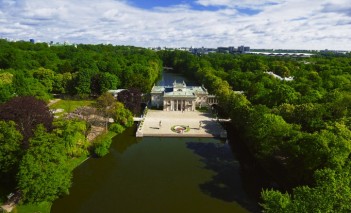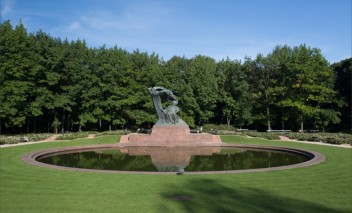"Virtuti Militari" Exhibition

Devoted to the highest and earliest Polish military decoration, the "Virtuti Militari" exhibition will be held in the Royal Łazienki Museum from 17 September until 11 December 2019. The history of the order founded by King Stanisław August is closely connected with the dramatic history of Poland.
The exhibition entitled "Virtuti Militari", held under the patronage of the Minister of Culture and National Heritage, will take place in the Officer Cadets School from 17 September 2019 to 30 November 2019: Tuesday-Sunday from 10.00 to 16.00, Friday from 10.00 to 18.00; from 1 to 11 December 2019: Tuesday to Sunday from 9.00 to 16.00, Saturday: from 9.00 to 18.00. Admission: standard ticket – PLN 10; reduced-price ticket – PLN 5; admission via voucher; admission free on Friday, from 7 to 11 December 2019 – PLN 1.
Virtuti Militari – Highest Military Decoration
The Virtuti Militari order was established by King Stanisław August on 22 June 1792. The idea was conceived by the King’s nephew, Prince Józef Poniatowski, who, on 18 June 1792, headed the armies of Poland in the Battle of Zieleńce in the Polish-Russian War in Defence of the Constitution. The "Governance Act" was the fruit of 30-year-long reformation efforts by the last King of Poland.
The Royal Łazienki Museum was the residence of Stanisław August, creator of the Order and its Grand Master. Prince Józef, co-creator and knight chevalier of the Order, was a guest at Łazienki and inherited it after the death of the King. The same institution is now hosting the exhibition devoted to the highest Polish military decoration, and the event is organized in a symbolic location – inside the Officer Cadets School. It was here that on 29 November 1830, Piotr Wysocki left for the Belvedere – in charge of the co-conspirators – initiating the fight to regain independence.
The history of Łazienki is intertwined with the history of Polish pro-independence efforts, awarded with the highest Polish military decoration. The Virtuti Militari Order was awarded to the heroes of national uprisings from late 18th century, throughout the periods of the Duchy of Warsaw, Congress Poland, and up until the 2nd and 3rd Republic – in each period of the Polish fight for independence, in the Kościuszko, November, January, Greater Poland and Silesian Uprisings, in Napoleonic Wars and both World Wars. The lives of many recipients of the order were in some way connected with Łazienki, including General Józef Bem, Colonel Piotr Wysocki, Marshal Józef Piłsudski, and General Bolesław Wieniawa-Długoszewski.
The "Virtuti Militari" exhibition presents the history of the earliest Polish military decoration recounted via the tales of several dozen personalities who received it. The exhibition includes decorations awarded for special military achievements, portraits of the national heroes, as well as archival documents, photographs and memorabilia connected with them.
The exhibition presents figures such as: Stanisław August, Józef Poniatowski, Tadeusz Kościuszko, Franciszek Ksawery Krasicki, Ambroży Skarzyński, Frederick Augustus I, Jan Konopka, Aleksander Fredro, Kalikst Horoch, Benedykt Kołyszko, Piotr Wysocki, Józef Chłopicki, Franciszek Dzierżykraj-Morawski, Louis Archinard, Karol Anders, Adam Borkiewicz, Wacław Brzozowski, Witold Czaykowski, Włodzimierz Dembiński, Stanisław Durlej, Bolesław Wieniawa-Długoszowski, Ferdinand Foch, Louis Nicolas Davout, Zygmunt Grabowski, Joseph Joffre, Wacław Makowski, Philippe Pétain, Józef Piłsudski, Mieczysław Boruta-Spiechowicz, Stanisław Szeptycki, Józef Wiatr, Alphonse Juin, Władysław Anders, Zygmunt Bohusz-Szyszko, Władysław Broniewski, Adolf Bocheński, Józef Bocheński, Lucjan Janiszewski, Ludomir Białecki, Kazimierz Dworak, Aleksander Gabszewicz, Antoni Grudziński, Eugeniusz Hinterhof, Julian Kowalski, John Alexander Kent, Edward Śmigły-Rydz, Nikodem Sulik, Mieczysław Sawicki, Mirosław Świeściak, Stanisław Sosabowski, Michał Sokolnicki, Władysław Ostrowski, Jan Michałowski, Stanisław Bogdan Mączyński, Jan Michałowski, Zygmunt Podhorski, Zbigniew Gustaw Bobiński, Tadeusz Stefan Alf-Tarczyński and Józef Kordian Zamorski.
Beginnings of Virtuti Militari
The idea of introducing a special military decoration was not new in late 18th century. Such orders already existed in Europe at the time. The first was the Order of Saint Louis, first awarded in 1693 r. In 1736, in the Electorate of Saxony, Military Order of St. Henry was established; in 1740, in Prussia – the Pour le Mérite Order, and in 1750 in Austria – Order of Elizabeth and Theresa, which was renamed in 1757 to the Military Order of Maria Theresa. In 1759, the Military Merit Order was founded in Württemberg. Those decorations were awarded mainly for merits and loyalty to the throne and to the ruling dynasty, and only officers of noble birth were eligible to receive them. This fact lends some uniqueness to the Virtuti Militari Order which was awarded to officers as well as normal soldiers.
The first decorations, certified by the Royal signature of 22 June 1792, were awarded to officers and soldiers who showed valour in the victorious Battle of Zieleńce (18 June 1792). The next group of recipients of the Order included the heroes of the Battle of Dubienka (18 July 1792). In total, the number of decorations awarded for the two battles and the entire Polish-Russian War amounted to 1 Commander’s Cross; 86 Knight’s Crosses (including golden medals) and 439 Silver Crosses (including silver medals).
The design and look of the "military tokens" awarded by the King were typical for the era. Initially, the medals were of oval shape, made of gold and silver, based on the design of the royal court medallist Jan Filip Holzhaeusser, and cast in the Warsaw Mint. According to the certificates granted to the recipients, they covered the orders in black enamel.
Virtuti Militari and efforts to regain independence
After the second partition of Poland, the country – covering a surface area of 200,000 square kilometres, with a population of four million people – once again lost the sovereignty that it had won during the Great Sejm. In March of 1794, Tadeusz Kościuszko prompted Poles to start an uprising.
The period of the Insurrection was not successful for the newly-established decoration. Kościuszko, the Supreme Commander of the Polish National Armed Forces, did not accept the 130 Virtuti Militari medals sent by Stanisław August. The refusal was most likely caused by the fact that the public opinion was critical of the King’s participation in the Targowica Confederation, and hence the reluctance to award an order that was associated with Stanisław August.
Kościuszko sent back 109 silver orders to the mint and ordered 21 golden ones to be recast into rings inscribed with the text, "Fatherland to Its Defender", which he awarded for valour in combat.
After the fall of the Kościuszko Insurrection, the Polish Republic disappeared from world maps after being ravaged by Russia, Prussia and Austria. Napoleon, who defeated the armies of all three occupants, gave a spark of hope for a restitution of at least some of Poland’s statehood. The dreams came true in the autumn of 1806, when the French Emperor allowed the establishment of the Duchy of Warsaw. The constitution imposed by Napoleon, modelled on the post-revolution France, brought revivifying social reforms and restored pre-partition decorations, including the Order of the Military Cross. The orders awarded in the Duchy of Warsaw amounted to: 2 Grand Crosses, 10 Commander’s Crosses, 501 Knight’s Crosses, 923 Golden Crosses and 1130 Silver Crosses.
After the Congress of Vienna (1815) and the creation of Congress Poland, which was dependent on Russia, the order retained its statutes and was renamed to Polish Military Medal. The decoration was awarded to the veterans of the Napoleonic campaigns of 1812, 1813 and 1814. The last medals were conferred around 1820.
After the outbreak of the November Uprising, the decoration was awarded again, reinstated under the name "Virtuti Militari Order" – by the act of the Sejm of 19 February 1831. During the revolution, the orders awarded amounted to 1 Commander’s Cross, 105 Knight’s Crosses, 1794 Golden Crosses and 1973 Silver Crosses. After the fall of the November Uprising, Tsar Nicholas I abolished the Virtuti Militari Order and, by way of the ordinance of 12 January 1832, degraded it to a Russian decoration to Tsarist soldiers who fought to quell the November Uprising.
After regaining independence, in November of 1918, in accordance with the Act of 1 August 1919, the Legislative Sejm of the Second Polish Republic reinstated the Order that had been founded in 1792 by King Stanisław August and named it the Military Award Virtuti Militari.
It was awarded by the decree of the Marshal of Poland Józef Piłsudski, at the request of the Provisional Chapter of the decoration, established on 1 January 1920. The next, permanent Chapter, created in 1922, worked to amend the act of 1919 and draw up new statutes. On 25 March 1933, President Ignacy Mościcki signed the Order of Virtuti Militari Act, which read: "The War Order Virtuti Militari is an award for outstanding military valour and absolute dedication, in accordance with the 'Honour and Fatherland' maxim".
During the Second Republic, 8389 Military Awards Virtuti Militari were awarded, also to foreigners.
The heroic defence of the country during the outbreak of World War II in 1939 created an incentive for new decorations. The first official decoration ceremony in the Polish Armed Forces took place on the British Isles. General Władysław Sikorski, acting as the Commander in Chief, believed that Virtuti Militari Crosses should not be awarded for the failed 1939 campaign. It was only after the 1940 French campaign that the order was again given for special merits in combat. After the evacuation of the Polish Army to Great Britain, the decoration was awarded to the soldiers of the Polish Armed Forces and the Union of Armed Struggle, and later the Home Army. The Commander in Chief was in charge of the decoration.
The participation of Poles in combat on all fronts of World War II forced military authorities to regulate the awarding process. On 15 October 1943, Commander in Chief General Kazimierz Sosnkowski established the Chapter of Virtuti Militari. Until the end of the War, only classes V and IV were awarded. Higher classes were to be awarded after the war.
The final orders for World War II merits in the Polish Armed Forces were accepted on 1 December 1947. From 1939 to 1947, 2 Commander’s Crosses, 6 Knight’s Crosses, 138 Golden Crosses and 4299 Silver Crosses were awarded. Other decorations for valour in combat during World War II were conferred by the Government in Exile.
In the country, communists quickly assumed the right to confer the order of Virtuti Militari. By the decree of 22 December 1944, the Polish Committee of National Liberation incorporated the Virtuti Militari Cross into the decorations of Communist Poland. The Knights’ Council, chapter and pension were abolished. The obverse of the order was also changed: the eagle was deprived of the crown and royal attributes. In 1945, communist authorities awarded the highest 1st class order to Soviet marshals and generals, including Aleksei Antonov, Nikolai Bulganin, Ivan Konev, Konstantin Rokossovsky and Georgy Zhukov. In 1976, in protest against the Communist regime awarding a 1st class order to Soviet leader Leonid Brezhnev, pre-war military leaders renounced their Virtuti Militari Orders in the Jasna Góra Monastery.
In 1992, after the political transformation, the Order regained its former, Second Republic design. Its name was restored to "War Order of Virtuti Militari". Special criteria for awarding were also defined (it may only be conferred by the President of Poland), similarly to the Act of 25 March 1933.
During the 227-year-long history of the Virtuti Militari Order, it was awarded to more than 26 thousand people.





